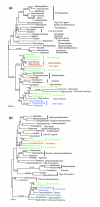Did an ancient chlamydial endosymbiosis facilitate the establishment of primary plastids?
- PMID: 17547748
- PMCID: PMC2394758
- DOI: 10.1186/gb-2007-8-6-r99
Did an ancient chlamydial endosymbiosis facilitate the establishment of primary plastids?
Abstract
Background: Ancient endosymbioses are responsible for the origins of mitochondria and plastids, and they contribute to the divergence of several major eukaryotic groups. Although chlamydiae, a group of obligate intracellular bacteria, are not found in plants, an unexpected number of chlamydial genes are most similar to plant homologs, which, interestingly, often contain a plastid-targeting signal. This observation has prompted several hypotheses, including gene transfer between chlamydiae and plant-related groups and an ancestral relationship between chlamydiae and cyanobacteria.
Results: We conducted phylogenomic analyses of the red alga Cyanidioschyzon merolae to identify genes specifically related to chlamydial homologs. We show that at least 21 genes were transferred between chlamydiae and primary photosynthetic eukaryotes, with the donor most similar to the environmental Protochlamydia. Such an unusually high number of transferred genes suggests an ancient chlamydial endosymbiosis with the ancestral primary photosynthetic eukaryote. We hypothesize that three organisms were involved in establishing the primary photosynthetic lineage: the eukaryotic host cell, the cyanobacterial endosymbiont that provided photosynthetic capability, and a chlamydial endosymbiont or parasite that facilitated the establishment of the cyanobacterial endosymbiont.
Conclusion: Our findings provide a glimpse into the complex interactions that were necessary to establish the primary endosymbiotic relationship between plastid and host cytoplasms, and thereby explain the rarity with which long-term successful endosymbiotic relationships between heterotrophs and photoautotrophs were established. Our data also provide strong and independent support for a common origin of all primary photosynthetic eukaryotes and of the plastids they harbor.
Figures



References
Publication types
MeSH terms
LinkOut - more resources
Full Text Sources
Other Literature Sources

